Growing saffron, the world’s most expensive spice, in your own garden, is a fascinating and rewarding endeavor.
As a spice that’s valued not just for its unique flavor but also for its rich history, growing saffron offers a truly unique gardening experience.
Derived from the flower of Crocus sativus, saffron cultivation requires patience and care, but the reward of harvesting your own saffron threads makes it a worthwhile endeavor.
In this article, we’ll explore the benefits of growing saffron, discuss some popular varieties, and provide essential care tips.
Benefits of Growing Saffron
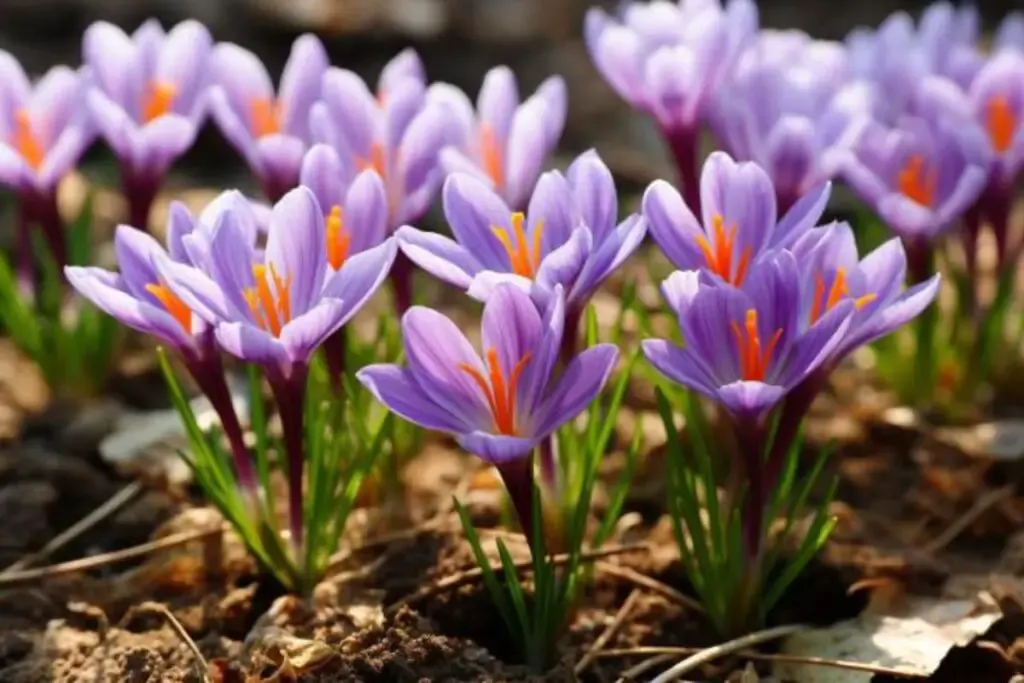
1. High Value
Saffron is renowned for being the most expensive spice in the world due to the labor-intensive process of harvesting the stigmas.
Growing your own saffron can be cost-effective and offers the satisfaction of producing a highly valued product right in your backyard.
2. Culinary Excellence
Freshly harvested saffron has an incomparable taste and aroma. By growing your own, you ensure the highest quality, unadulterated spice for your cooking, enhancing dishes with its distinctive flavor.
3. Ornamental Beauty
The saffron crocus is not only valuable for its stigmas but also adds beauty to your garden with its purple flowers.
Blooming in the fall brings color and life to your garden when most other plants are starting to fade.
My Favorite Saffron Varieties
There aren’t many varieties of the saffron crocus (Crocus sativus), as this specific species is required for true saffron. However, different strains or selections can vary slightly in terms of flower size, vigor, and yield.
Here are three you might come across:
1. Iranian Saffron
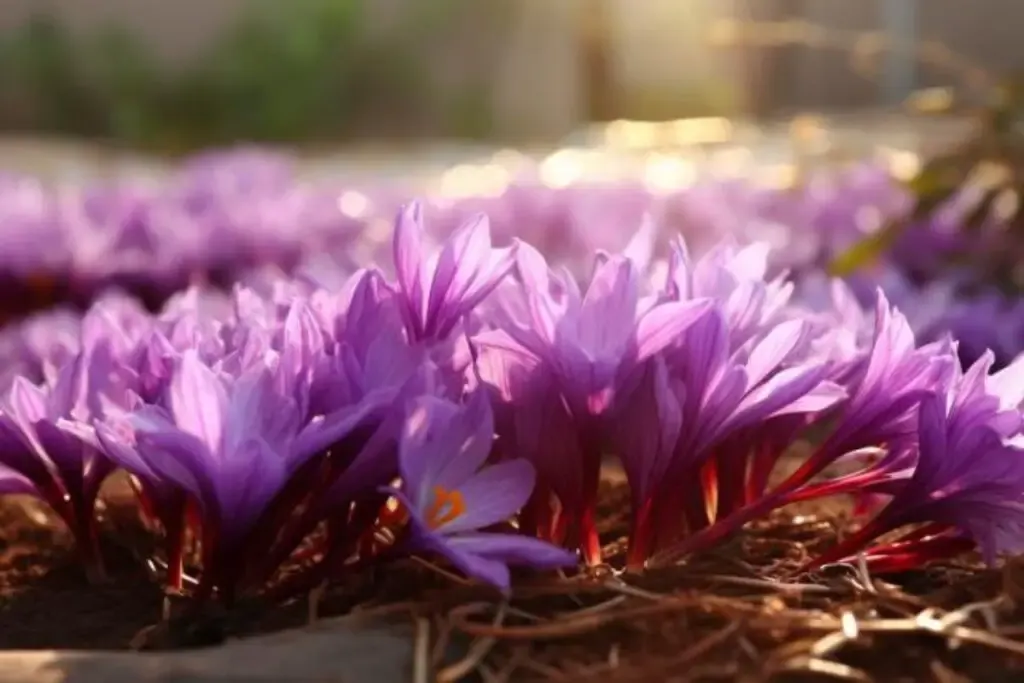
Known for its deep color and strong flavor, Iranian saffron is highly sought after. It’s characterized by long, dark red stigmas.
2. Kashmiri Saffron
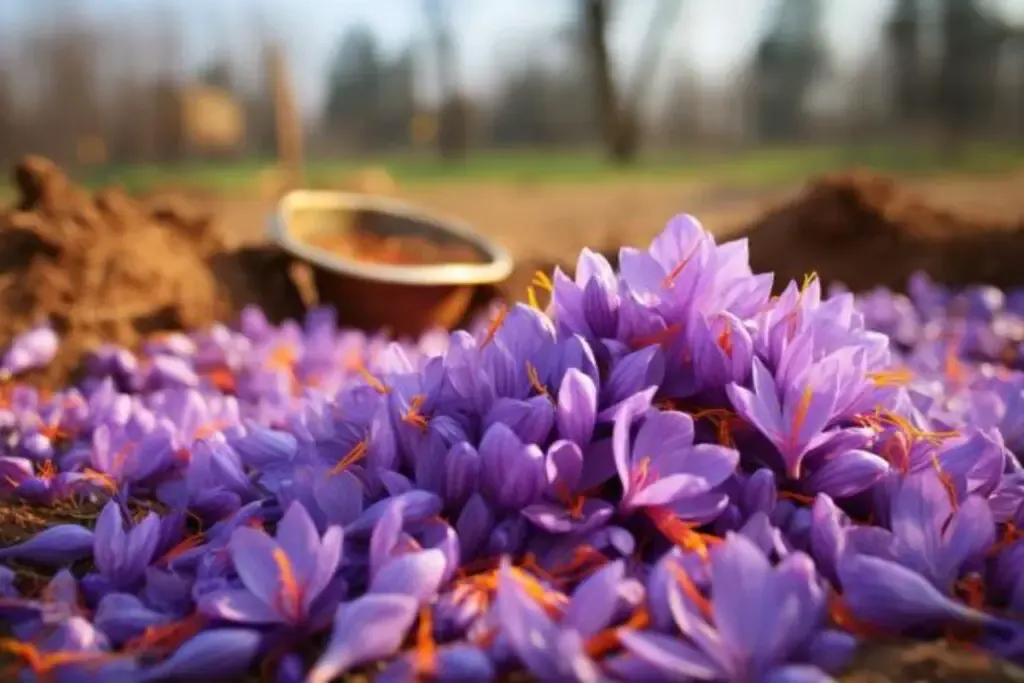
This variety, grown in the Kashmir region of India, is prized for its intense aroma and dark color. It’s often considered some of the best quality saffron available.
3. Spanish Saffron
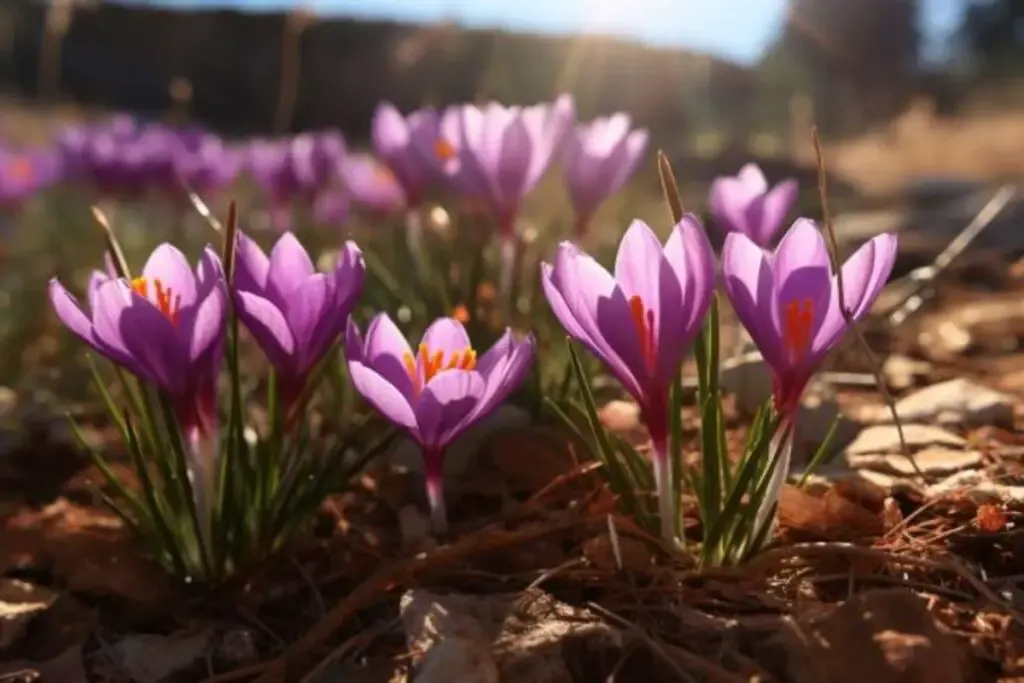
Spanish saffron, particularly from the La Mancha region, is also well-regarded. It tends to have a slightly lighter color but is valued for its high quality.
Saffron Care
Caring for saffron crocuses requires an understanding of their unique growth cycle and needs.
These beautiful and valuable plants demand attention to detail, but their care is not beyond the reach of an enthusiastic gardener.
Let’s delve into the specifics of saffron care, including planting, light requirements, soil preferences, water needs, temperature and humidity considerations, and fertilizer usage.
Planting
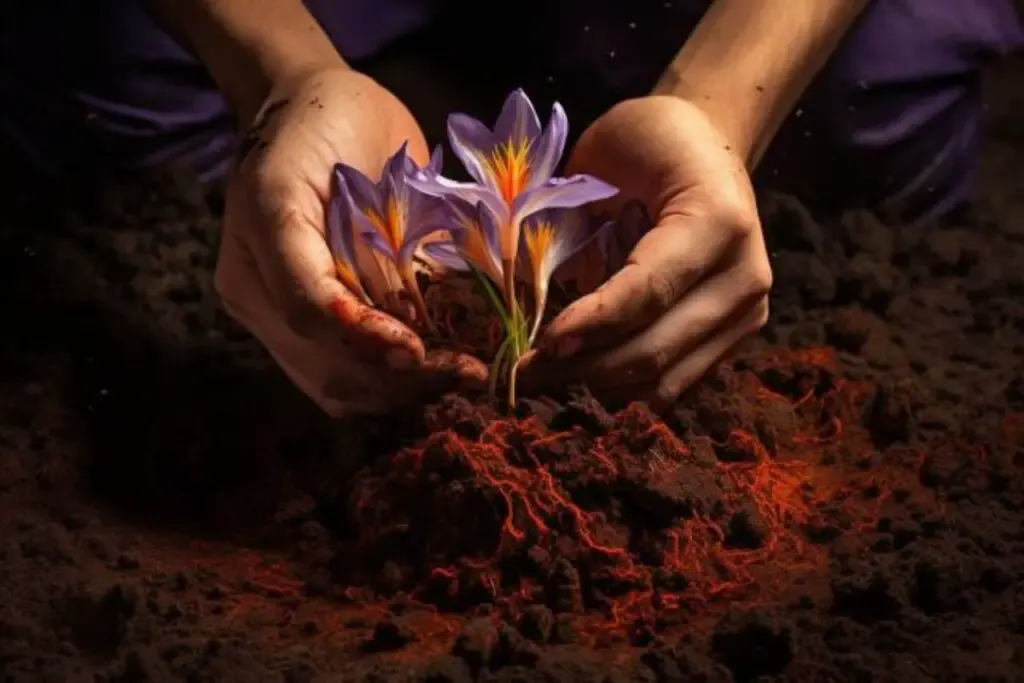
Saffron bulbs, or corms, should be planted in late summer or early fall. Plant them about 3-4 inches deep and 6 inches apart to allow enough space for the plants to grow and multiply over time.
It’s essential to plant the corms at the correct depth to ensure successful growth and flowering.
Light
Saffron crocuses thrive in full sunlight. Choose a planting site that receives at least 6-8 hours of direct sunlight daily.
Adequate sun exposure is vital for the flowers to develop properly and for the production of high-quality saffron stigmas.
Soil
Well-draining soil is crucial for saffron. The corms are prone to rot in waterlogged conditions, so ensure your soil is loose and drains well.
Adding sand or organic matter can improve soil texture. Saffron prefers a neutral to slightly alkaline pH.
Water
While saffron corms require moist soil to start growing, they don’t like overly wet conditions. Water the plants moderately when the soil feels dry to the touch, but be careful not to overwater.
Once the plants have flowered, reduce watering as the corms enter a dormant stage.
Temperature and Humidity
Saffron crocuses are well-suited to climates with hot, dry summers and cool to cold winters. They can tolerate light frosts, but extreme cold or prolonged wet conditions can damage the corms.
In very humid climates, ensuring good air circulation and soil drainage is especially important.
Fertilizer
A light application of a balanced, all-purpose fertilizer can be beneficial at the time of planting. However, saffron generally does not require heavy feeding.
Over-fertilizing can lead to excess foliage growth at the expense of flower production.
Harvesting Saffron
Harvesting saffron is a meticulous but rewarding process. The saffron spice comes from the red stigmas of the crocus flower.
These stigmas need to be handpicked, ideally early in the morning after the flowers have opened but before they wilt.
Each flower only produces three stigmas, so a significant number of flowers are needed for a small amount of saffron. After harvesting, dry the stigmas thoroughly before storing them to preserve their flavor and quality.
Pruning
Pruning isn’t a significant part of saffron care since the plant naturally dies back after flowering.
However, after the flowers have faded, and the leaves start to yellow and die back (usually by late spring), you can trim away the dead foliage.
This helps keep the planting area tidy and can help prevent fungal diseases.
Propagating
Saffron is typically propagated by dividing the corms. Every few years, the corms multiply and can become crowded, leading to a decrease in flowering.
Dig up the corms after the foliage has died back, gently separate them, and replant them with adequate space for growth. This is usually done in the summer when the corms are dormant.
How to Grow Saffron From Seed
Growing saffron from seed is not commonly practiced, as the plant is usually propagated from corms.
Moreover, saffron seeds can be difficult to come by and may not produce plants identical to the parent. For most gardeners, purchasing corms is the most reliable and straightforward method to start growing saffron.
Growing in Pots
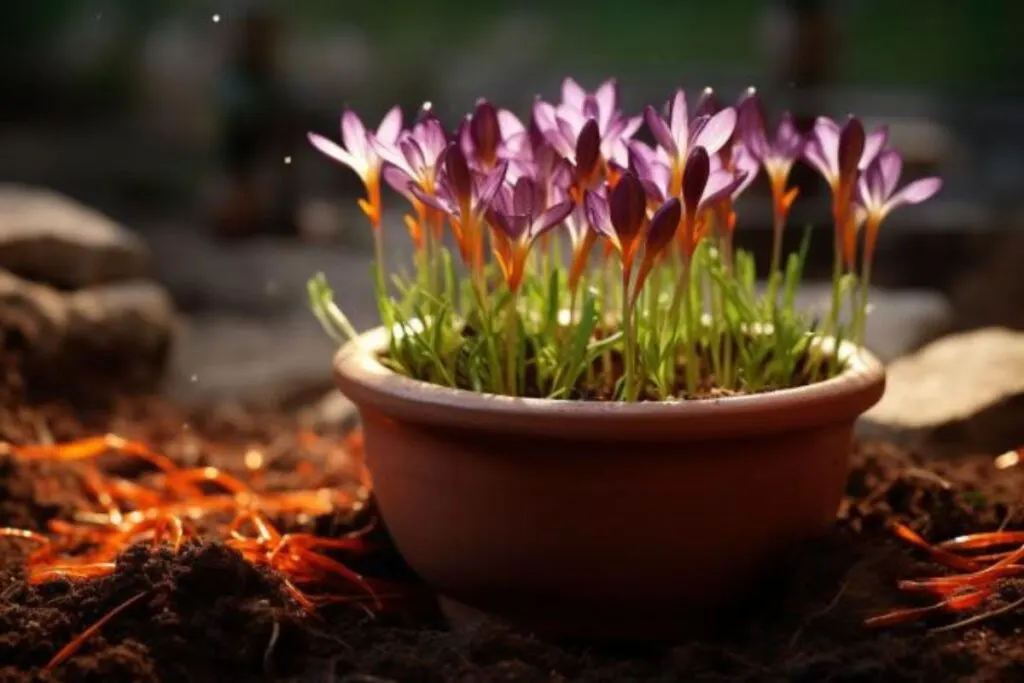
Saffron can be grown in pots, especially in climates where the ground may be too wet or cold. Choose a deep pot with good drainage, as saffron corms are prone to rot in waterlogged soil.
Ensure the pot is placed in a sunny spot and watered moderately. Repotting and dividing the corms every few years will help maintain the health and productivity of the plants.
Overwintering
Overwintering saffron crocuses requires some care, especially in regions with harsh winters. Saffron corms are relatively hardy, but they can be susceptible to rotting in wet conditions.
If your area experiences heavy rainfall or snow, it’s important to ensure that the soil drains well.
In colder climates, applying a layer of mulch over the planting area can provide additional insulation and protection against freezing temperatures.
However, be cautious not to over-mulch, as this can retain too much moisture.
Transplanting
Transplanting saffron is typically done during the dormancy period in summer. If your saffron plants have become overcrowded, carefully dig up the corms and select the healthiest ones for replanting.
Replant them immediately at the recommended depth and spacing to encourage robust growth for the next season.
Transplanting is a great opportunity to expand your saffron crop or to renew older plantings that have become less productive.
Common Pests & Diseases
Saffron crocuses are generally not prone to many pests, but they can be affected by corm rot, particularly in wet or poorly drained soils.
It’s crucial to plant them in well-draining soil and avoid overwatering. Additionally, keep an eye out for signs of fungal diseases like saffron rust, which can be mitigated by ensuring good air circulation around the plants and practicing crop rotation.
Growing saffron is a journey that combines the joys of gardening with the delight of harvesting a spice revered across cultures and cuisines.
It’s a process that teaches patience and care, rewarding the gardener with the vibrant hues and distinctive flavors of homegrown saffron.
Whether you’re a seasoned gardener or a curious novice, growing saffron offers a unique opportunity to expand your gardening horizons and spice up your culinary adventures.
Remember, the key to successful saffron cultivation lies in understanding and meeting the specific needs of these precious crocuses.

